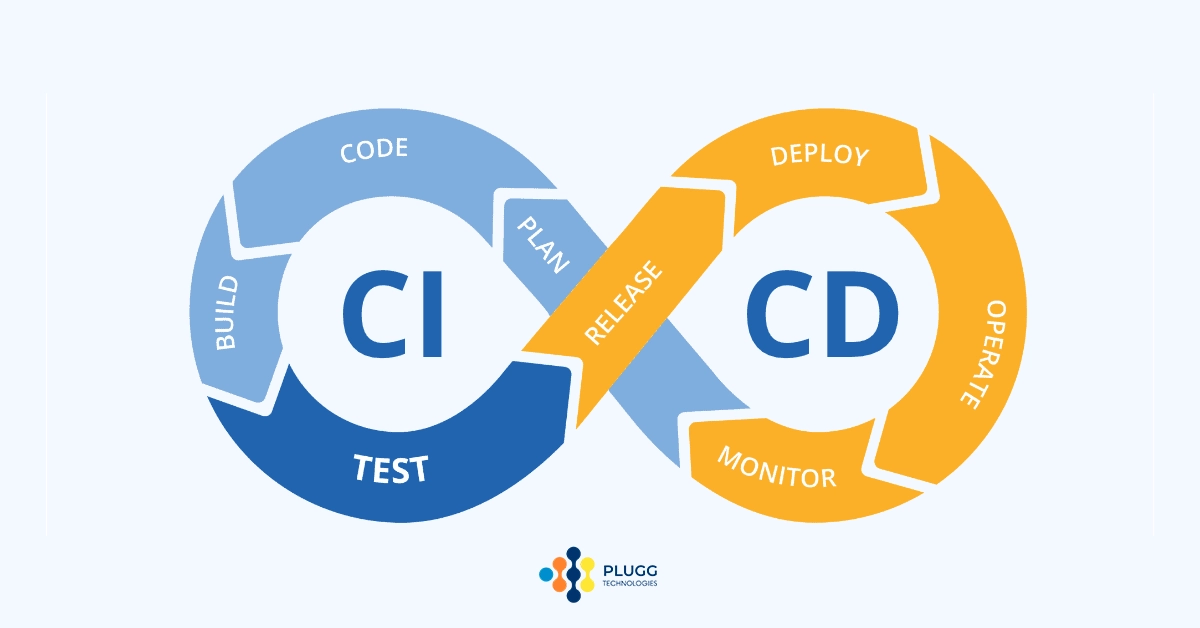
In the world of modern software development, agility and efficiency are everything. Companies must deliver high-quality software at a rapid pace to stay competitive. This is where Continuous Integration and Continuous Deployment (CI/CD) comes into play. Businesses that implement CI/CD pipelines see faster time to market, improved collaboration, and a significant reduction in deployment failures.
In this blog, we’ll break down everything you need to know about CI/CD, how it transforms software development, and how Plugg Technologies connects businesses with the top CI/CD talent in Latin America. Whether you’re new to CI/CD or looking to optimize your current pipeline, this guide will give you the insights you need to succeed.
CI/CD stands for Continuous Integration and Continuous Deployment (or Continuous Delivery). It refers to a set of best practices that automate code integration, testing, and deployment. These practices allow development teams to release updates faster, with fewer errors and greater efficiency.
For a deep dive into the fundamentals of CI/CD, you can refer to the Wikipedia page on CI/CD.
In traditional software development, integrating and deploying code changes was often time-consuming and error-prone. Teams would write massive updates over weeks or months before merging them, leading to conflicts, bugs, and production delays. CI/CD solves this by enabling frequent, small code integrations that are automatically tested and deployed.
This approach ensures that software is always in a deployable state, reducing the risk of major system failures and accelerating innovation. Learn more about the significance of CI/CD from the experts at Atlassian.
Continuous Integration (CI) focuses on automating the integration of code changes. Developers commit their changes to a shared repository multiple times a day.
Each integration triggers:
Automated Builds – The system compiles the updated code to ensure it runs correctly.
Automated Testing – A series of tests checks for bugs, security vulnerabilities, and performance issues.
Error Reporting – If the build or tests fail, the system provides immediate feedback so developers can resolve issues quickly.
By detecting issues early, CI helps maintain a stable and high-quality codebase. You can explore more about CI best practices from Google Cloud’s CI/CD guide.
Continuous Deployment (CD) extends CI by automating the deployment of code changes. Once updates pass all tests, they are automatically deployed to production or staging environments without manual intervention.
CD ensures:
Fast, Reliable Releases – Updates can be deployed in real time, eliminating delays caused by manual approvals.
Rollback Capabilities – If a deployment introduces issues, automated rollback procedures can quickly restore the previous stable version.
Minimal Downtime – Automated deployments allow businesses to release new features without interrupting user experience.
Many companies opt for Continuous Delivery instead of Continuous Deployment, where changes are prepared for deployment but require manual approval before release. The Red Hat CI/CD guide provides a great overview of this concept.

Implementing CI/CD in your development process offers several advantages, including:
Faster Time to Market – Automated builds and deployments reduce the time required to deliver new features.
Higher Software Quality – Frequent testing and integration help catch bugs early.
Improved Collaboration – CI/CD promotes seamless coordination between developers, testers, and operations teams.
Reduced Manual Effort – Automation eliminates repetitive tasks, allowing developers to focus on innovation.
Scalability – CI/CD processes can handle growing workloads without compromising performance.
For an industry perspective on these benefits, check out DevOps.com’s insights on CI/CD.
To build an efficient CI/CD pipeline, teams need the following components:
A VCS like Git, GitHub, GitLab, or Bitbucket tracks changes to the codebase and ensures smooth collaboration among developers. Learn more about version control from GitHub Docs.
Tools like Jenkins, CircleCI, and GitLab CI/CD compile code automatically, reducing manual intervention.
Testing tools like Selenium, JUnit, and Postman validate code quality by running unit, integration, and end-to-end tests. Check out Selenium’s official site for automated testing strategies.
Tools such as Terraform, Kubernetes, and Docker streamline deployment processes, ensuring rapid and consistent releases. Visit Kubernetes’ official site to learn how orchestration improves CD processes.
While CI/CD brings efficiency, its implementation requires careful planning. Here’s how you can optimize your pipeline:
Slow Build Times – Long build processes delay feedback loops.
Flaky Tests – Inconsistent test results reduce trust in automation.
Security Concerns – Deploying code rapidly increases security risks.
Maintain a Single Source of Truth – Keep all code in one repository.
Automate Everything – From testing to deployment, minimize manual effort.
Keep Builds Fast – Optimize pipelines to run quickly.
Implement Robust Security Measures – Use DevSecOps to integrate security into the CI/CD process.
Monitor and Optimize – Continuously analyze pipeline performance.
The Microsoft DevOps resource hub offers additional guidance on best practices.
At Plugg Technologies, we specialize in connecting US businesses with highly skilled CI/CD professionals from Latin America. Our experts have experience with:
Jenkins, GitLab, and CircleCI for automated builds
Selenium, JUnit, and Cypress for testing
Kubernetes, Terraform, and Docker for deployment
Our nearshore developers provide the expertise needed to accelerate software delivery, improve reliability, and enhance security.
By partnering with Plugg Technologies, you gain access to top-tier CI/CD talent who can help your company scale and innovate efficiently.
Are you ready to implement CI/CD in your software development process? Plugg Technologies can help you build a high-performing, cost-effective team in Latin America. Contact us today to discover how our expert developers can streamline your CI/CD pipeline.
Get Started Today Have questions? Contact us! We are always here to help!
Related Post 👉 What is Software Development Lifecycle (SDLC)?
Ready to Grow With a Team That’s Invested in Your Success?
At Plugg Technologies, we connect you to nearshore talent that brings real advantages: shared time zones for easier collaboration, strong English proficiency for clear communication, and significant cost savings without compromising quality.
Beyond top talent, we deliver thoughtful guidance and premium, white-glove service — all backed by deep expertise in Latin America and a genuine commitment to your success.
©2025 Plugg Technologies. All Rights Reserved